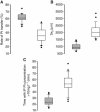Intraperitoneal clearance as a potential biomarker of cisplatin after intraperitoneal perioperative chemotherapy: a population pharmacokinetic study
- PMID: 22173671
- PMCID: PMC3273361
- DOI: 10.1038/bjc.2011.557
Intraperitoneal clearance as a potential biomarker of cisplatin after intraperitoneal perioperative chemotherapy: a population pharmacokinetic study
Abstract
Background: Intraperitoneal (IP) perioperative chemotherapy with cisplatin is an interesting option in ovarian cancer treatment. A combination of cisplatin with IP epinephrine (already shown to improve IP and decrease systemic platinum (Pt) exposure) was evaluated using a population pharmacokinetic analysis.
Methods: Data from 55 patients treated with cisplatin-based IP perioperative chemotherapy with (n=26) or without (n=29) epinephrine were analysed using NONMEM.
Results: Epinephrine halves clearance between peritoneum and serum (IPCL) and increases the Pt central volume of distribution, IP exposure and penetration in tissue. IPCL has a better predictive value than any other parameter with respect to renal toxicity.
Conclusion: This confirms that IPCL could be useful in assessing renal toxicity. As IPCL is also linked to tissue penetration and IP exposure, it may be proposed as biomarker. In addition to a Bayesian estimation, we propose a single-sample calculation-way to assess it. Prospective studies are needed to validate IPCL as a biomarker in this context.
Conflict of interest statement
The authors declare no conflict of interest.
Figures



Similar articles
-
Population pharmacokinetics and dosing recommendations for cisplatin during intraperitoneal peroperative administration: development of a limited sampling strategy for toxicity risk assessment.Clin Pharmacokinet. 2009;48(3):169-80. doi: 10.2165/00003088-200948030-00003. Clin Pharmacokinet. 2009. PMID: 19385710
-
Improvement in intraperitoneal intraoperative cisplatin exposure based on pharmacokinetic analysis in patients with ovarian cancer.Cancer Chemother Pharmacol. 2008 Mar;61(3):415-21. doi: 10.1007/s00280-007-0484-x. Epub 2007 May 15. Cancer Chemother Pharmacol. 2008. PMID: 17503047
-
[Pharmacokinetics study of intraperitoneal cisplatin in ovarian carcinoma].Zhonghua Fu Chan Ke Za Zhi. 1993 Apr;28(4):224-6, 254. Zhonghua Fu Chan Ke Za Zhi. 1993. PMID: 8404307 Chinese.
-
[Pharmacological bases of intraperitoneal chemotherapy].Bull Cancer. 2009 Dec;96(12):1235-42. doi: 10.1684/bdc.2009.0982. Bull Cancer. 2009. PMID: 19923051 Review. French.
-
Intraperitoneal chemotherapy in advanced epithelial ovarian cancer: a survey.Arch Gynecol Obstet. 2014 Sep;290(3):425-34. doi: 10.1007/s00404-014-3252-2. Epub 2014 May 21. Arch Gynecol Obstet. 2014. PMID: 24845970 Review.
Cited by
-
Mathematical modeling of intraperitoneal drug delivery: simulation of drug distribution in a single tumor nodule.Drug Deliv. 2017 Nov;24(1):491-501. doi: 10.1080/10717544.2016.1269848. Drug Deliv. 2017. PMID: 28181817 Free PMC article.
-
Dexmedetomidine protects against cisplatin-induced acute kidney injury in mice through regulating apoptosis and inflammation.Inflamm Res. 2017 May;66(5):399-411. doi: 10.1007/s00011-017-1023-9. Epub 2017 Feb 21. Inflamm Res. 2017. PMID: 28224201
-
A 3D CFD model of the interstitial fluid pressure and drug distribution in heterogeneous tumor nodules during intraperitoneal chemotherapy.Drug Deliv. 2019 Dec;26(1):404-415. doi: 10.1080/10717544.2019.1588423. Drug Deliv. 2019. PMID: 30929523 Free PMC article.
-
Cytoreductive Surgery and Intraperitoneal Chemotherapy in Advanced Serous Epithelial Ovarian Cancer: A 14-Year French Retrospective Single-Center Study of 124 Patients.Ann Surg Oncol. 2022 May;29(5):3322-3334. doi: 10.1245/s10434-021-11211-7. Epub 2022 Jan 7. Ann Surg Oncol. 2022. PMID: 34994906
-
Modelling drug transport during intraperitoneal chemotherapy.Pleura Peritoneum. 2017 Jun 1;2(2):73-83. doi: 10.1515/pp-2017-0004. Epub 2017 Apr 14. Pleura Peritoneum. 2017. PMID: 30911635 Free PMC article. Review.
References
-
- Aebi S, Castiglione M (2008) Epithelial ovarian carcinoma: ESMO clinical recommendations for diagnosis, treatment and follow-up. Ann Oncol 19(Suppl 2): ii14–ii16 - PubMed
-
- Alberts DS, Liu PY, Hannigan EV, O’Toole R, Williams SD, Young JA, Franklin EW, Clarke-Pearson DL, Malviya VK, DuBeshter B (1996) Intraperitoneal cisplatin plus intravenous cyclophosphamide versus intravenous cisplatin plus intravenous cyclophosphamide for stage III ovarian cancer. N Engl J Med 335: 1950–1955 - PubMed
-
- Armstrong DK, Bundy B, Wenzel L, Huang HQ, Baergen R, Lele S, Copeland LJ, Walker JL, Burger RA (2006) Intraperitoneal cisplatin and paclitaxel in ovarian cancer. N Engl J Med 354: 34–43 - PubMed
-
- Beal SL, Sheiner LB, Boeckmann AJ NONMEM Users Guides. Ellicott City MD 1989-2006
Publication types
MeSH terms
Substances
LinkOut - more resources
Full Text Sources
Medical
Research Materials

